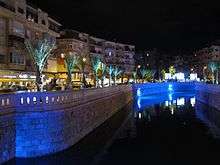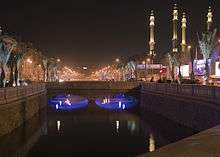Queiq
The Queiq[1] (Modern Standard Arabic: قويق, Quwayq, [quˈwajq]; northern Syrian Arabic: ʾWēʾ, [ʔwɛːʔ]), with many variant spellings,[5] anciently known as the Belus (Greek: Βήλος, Bēlos)[3] and Chalos, and also known in English as the Aleppo River, is a river and valley of the Aleppo Governorate, Syria and Turkey. It is a 129 kilometres (80 mi)-long river that flows through the northern Syrian city of Aleppo. It arises from the southern Aintab plateau in southeastern Turkey. The Akpınar River in the Kilis plain is one of the headwaters of the Queiq. The former town of Qinnasrin lay on its banks.[1] It partly flows along the western rim of the Matah Depression.[6] The valley has been occupied for thousands of years and in ancient times the Queiq valley was noted for its flint industries and pottery.[7]

The river dried up completely in the late 1960s, due to irrigation projects on the Turkish side of the border. Recently, water from the Euphrates has been diverted to revive the dead river, and thus revive agriculture in the plains south of Aleppo, but many Syrians remain bitter towards the Turks over their handling of the river.[8]
Queiq-River Massacre
In late January 2013, during the Syrian Civil War, the bodies of approximately 110 men and boys, most with hands bound behind the back, mouths sealed with tape, and gunshot wounds to the head, were found on the edges of the river in a part of Aleppo controlled by opposition forces. Very few of the victims were over 30. Many victims showed signs of torture.[9] Human Rights Watch reported that family members of many of the victims testified that they were last seen in a government-controlled area or after they set out to cross into the area through two checkpoints, one manned by opposition forces and the other by government forces. Most of the families interviewed by Human Rights Watch insisted that the victims had not been involved with the armed opposition or actively participated in demonstrations. They said, in many cases, that the victims were merchants. Some had shops in the government-controlled area but lived in the opposition-controlled area, and others regularly crossed into the government-controlled area to buy supplies that they sold in markets in the opposition-controlled area.[10] The victims are believed to have been detained, tortured, executed, and dumped by government forces into the river over a period of several weeks. The bodies floated downstream from a government held portion of the river into a rebel held portion in the Bustan al-Qasr district.[9] The bodies only became apparent when the winter high waters receded in late January. In February, a grate was lowered from a bridge into the river in opposition held territory to help catch other bodies floating down.
Between February and mid-March 2013, between 80 and 120 additional bodies were dragged from the river. An average of several bodies every day.[4] The continual appearance of these bodies has led the Queiq River to be referred to as "The River of Martyrs" by locals.[9][11] In March, a film crew from Britain's Channel 4, filmed residents pulling four bodies from the river on a single morning.[12] At the end of March, Aleppo's opposition authorities reduced the level of the water in the river so it could no longer carry bodies downstream. As a result, locals have been spared from fishing out dead bodies from the river.[13]
The Syrian Institute for Justice investigated in this case and held a press conference to reveal the truth of that crime. Abdulkader Mandou, the Head Manager of Syrian Institute for Justice, who is a human rights attorney, is leading this case. He hopes that they may present this case file to an international tribunal as part of transitional justice in Syria.
Gallery
- The flood of Queiq River in February 1922
- The river crossing the Aleppo Public Park in the 1950s
 The river in 2010, downtown Aleppo
The river in 2010, downtown Aleppo
References
| Wikimedia Commons has media related to Quweik River. |
- Phenix, Robert R. (20 December 2008). The sermons on Joseph of Balai of Qenneshrin: rhetoric and interpretation in fifth-century Syriac literature. Mohr Siebeck. p. 53. ISBN 978-3-16-149676-9. Retrieved 30 September 2011.
- Liverani, Mario (1995). Neo-Assyrian geography. Università di Roma, Dipartimento di scienze storiche, archeologiche e antropologiche dell'Antichità. p. 121. Retrieved 30 September 2011.
- Cohen, Getzel M. (2006), Hellenistic Settlements in Syria, the Red Sea Basin, and North Africa, Hellenistic Culture and Society, Vol. 46, Los Angeles: University of California Press, p. 145, ISBN 9780520931022.
- "Aleppo's river of death – Global Public Square - CNN.com Blogs". Globalpublicsquare.blogs.cnn.com. 2013-03-11. Retrieved 2014-08-24.
- Including Qoueiq,[2] Qoueiq,[3] Kweik,[4] and Quweiq.
- Wagner, Wolfgang (25 July 2011). Groundwater in the Arab Middle East. Springer. p. 165. ISBN 978-3-642-19350-7. Retrieved 30 September 2011.
- Peregrine, Peter Neal; Ember, Melvin; inc, Human Relations Area Files (2002). Encyclopedia of Prehistory: South and Southwest Asia. Springer. p. 42. ISBN 978-0-306-46262-7. Retrieved 30 September 2011.
- Gren, Erik (2002). Orientalia Suecana. Almquist & Wiksell Periodical Co. p. 37. Retrieved 30 September 2011.
- Chulov, Martin; Khalili, Mustafa; Payne-Frank, Noah (2013-03-10). "Syria: the story behind one of the most shocking images of the war | World news". London: The Guardian. Retrieved 2014-08-24.
- "Syria: A Stream of Bodies in Aleppo's River | Human Rights Watch". Hrw.org. 2013-06-04. Retrieved 2014-08-24.
- "Twenty bodies turn up in Aleppo's river of martyrs". Reuters. 2013-03-10. Retrieved 2014-08-24.
- 03/27/2013 3:23 pm EDT (2013-03-27). "Aleppo's Children: Channel 4 Documentary Chronicles Misery In Syria". Huffingtonpost.com. Retrieved 2014-08-24.
- Ole Solvang. "Syria's River of Death". The Daily Beast. Retrieved 2014-08-24.